The Challenge of Complex Project Staffing
Managing resources across multifaceted projects poses significant challenges for organizations, from avoiding bottlenecks to balancing workloads efficiently. Emerging resource planning platforms harness advanced technologies and smart automation to meet these challenges head-on, simplifying complex staffing requirements and driving project success. This article explores how the latest platforms are revolutionizing resource management through real-time data, AI-driven insights, and seamless integrations, offering firms the tools to optimize their workforce and budgets effectively.
Understanding Modern Resource Management Software
What are the key functionalities of resource management software?
Resource management software enables real-time project planning, resource tracking, and workload balancing to prevent delays, bottlenecks, and cost overruns. It supports automated scheduling, time and budget management, collaboration tools, dashboards, and workflow automation, all designed to boost productivity and enhance team coordination.
What core features are essential for effective resource planning?
Key features include resource allocation and scheduling capabilities, centralized project data management, time tracking, and budget oversight. Collaboration tools facilitate communication across teams, while dashboards provide real-time visibility into project status and resource utilization. Automation helps streamline routine tasks, such as automatic task assignment and schedule adjustments, freeing up managers to focus on strategic planning.
How do these tools benefit project teams and organizations?
By increasing the accuracy of resource allocation and minimizing scheduling conflicts, resource management software leads to improved project outcomes. Organizations experience higher productivity and cost savings through optimized workloads and fewer manual interventions. Real-time insights support proactive decision-making, reducing risks and enabling smoother project delivery. Enhanced collaboration features unite teams and stakeholders, fostering transparency and seamless communication throughout the project lifecycle.
Critical Techniques in Effective Resource Planning
Which techniques ensure efficient resource planning?
Effective resource planning employs several essential techniques to manage workloads and optimize project success. Three primary methods are resource allocation, resource leveling, and resource smoothing.
Resource allocation involves assigning the right resources to the right tasks based on availability and skillsets. This ensures that team members are used efficiently, avoiding underuse or overallocation.
Resource leveling helps in resolving conflicts that arise when resources are overbooked. By adjusting task schedules, resource leveling balances workload distribution, preventing bottlenecks and reducing delays.
Resource smoothing focuses on maintaining a consistent workload without extending project timelines. It redistributes resources to minimize peaks and troughs, making project execution more predictable.
Together, these techniques enhance resource utilization, prevent scheduling conflicts, and ultimately improve project delivery quality and timeliness. Implementing these techniques helps teams avoid overburdening resources and supports better decision-making throughout the project lifecycle, contributing to higher chances of project success.
AI-Powered Scheduling: A New Era with Dayshape
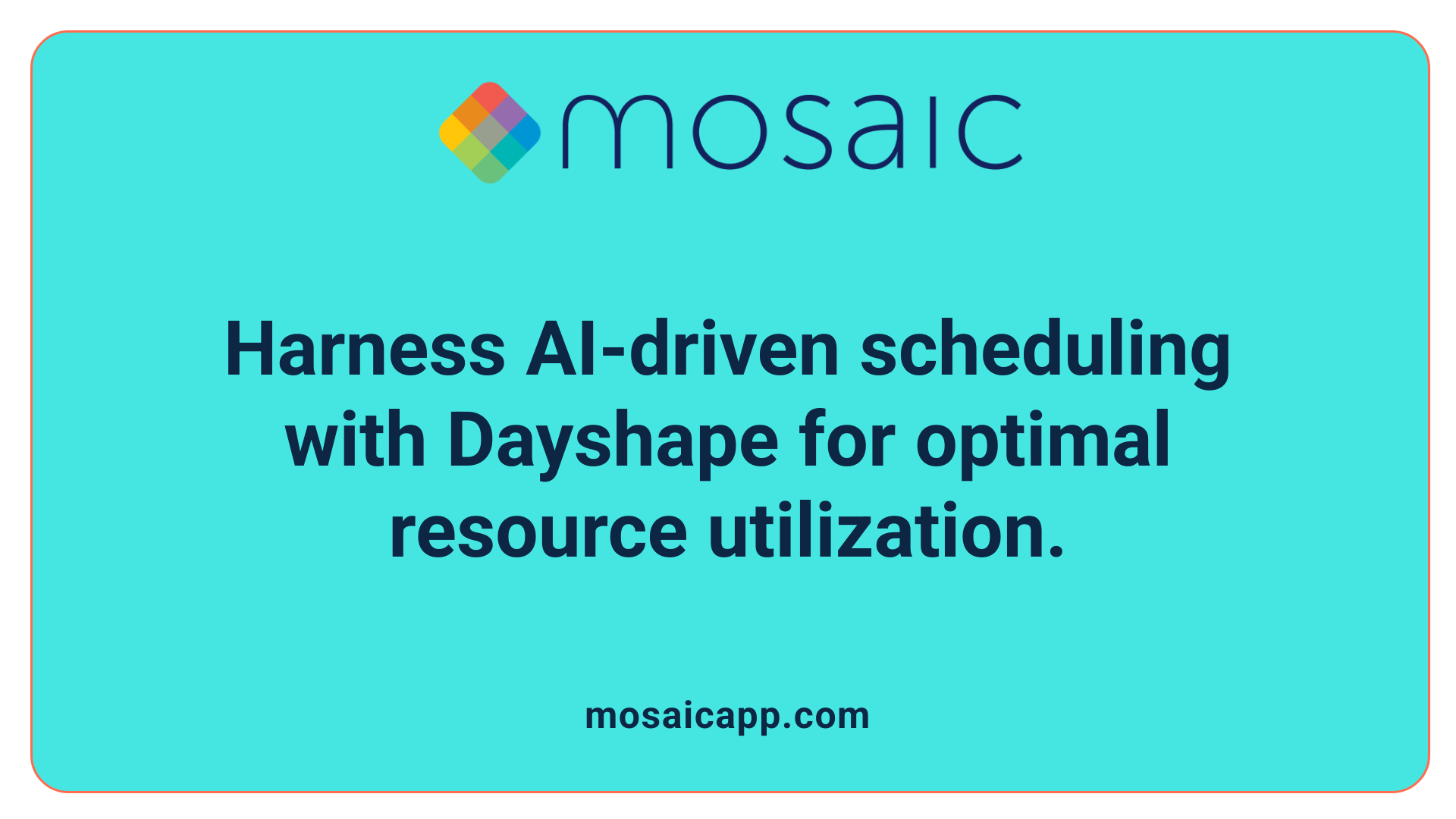
How does AI improve resource scheduling in complex professional services firms?
Dayshape revolutionizes resource management by leveraging AI to optimize scheduling for large, complex professional services firms with more than 500 employees. Its AI-based resource scheduling balances workloads across multiple projects, increasing utilization rates by approximately 3-6%. This intelligent system anticipates and adjusts resource assignments in real-time, reducing bottlenecks and inefficiencies.
Firm-wide AI resource scheduling
The platform’s AI advisory tool analyzes the availability and skills of resources firm-wide, enabling automated and optimized scheduling decisions. This ensures high-priority projects receive the right attention without overloading teams, harmonizing operational capacity with project demands.
Integration with ERP and practice management systems
Dayshape seamlessly integrates with major ERP, PSA, and practice management systems such as Workday, Salesforce, SAP, Oracle, and Microsoft. This interoperability connects scheduling data with financials and operational workflows, providing a unified view essential for smarter resource and budget planning.
Performance metrics dashboards
Dayshape offers intuitive dashboards featuring Gantt views, heatmaps, and live performance metrics. These dashboards provide actionable insights into project progress, resource utilization, and financial impacts, helping leadership make informed decisions quickly. Filters and heatmaps help pinpoint scheduling conflicts and capacity issues before they escalate.
Together, these features position Dayshape as a powerful AI-driven solution that enhances resource allocation precision and operational visibility in professional services, ultimately driving improved productivity and profitability.
Tailoring Platforms to Firm Size and Complexity
How do resource management platforms differ according to organizational needs?
Resource management platforms are designed with varying levels of complexity and functionality to suit the specific requirements of different organizational sizes and industries. Large professional services firms, particularly those with over 500 employees, benefit from robust platforms like Dayshape, which integrates advanced AI capabilities and real-time financial data to optimize scheduling and operational efficiency. Dayshape’s firm-wide AI-based scheduling and seamless integrations with ERP, PSA, and major systems like Salesforce, SAP, and Oracle make it ideal for handling the complexities of sizable organizations.
On the other hand, smaller teams and companies often opt for lighter, more straightforward tools such as Resource Guru, Float, or monday work management. These platforms focus on fundamental resource allocation, scheduling, and workload balancing without the complexity that larger firms demand. They provide ease of use and flexibility to manage smaller-scale projects efficiently.
Specialization by industry needs
Resource management software also specializes by industry. For example, BigTime targets growing professional services firms by combining resource planning with financial modeling, enabling proactive budget management and better profitability tracking. Motion, powered by AI, is designed to optimize task scheduling dynamically, using predictive alerts to prevent project delays and automate workflow progression. Platforms like Atlassian’s Jira and Confluence cater to enterprises needing agile project management and advanced collaboration tools, favored by organizations such as Amazon and NASA.
Examples of platform differentiation
| Platform | Organization Size | Specialized Features |
|---|---|---|
| Dayshape | Large firms (500+ employees) | AI-driven scheduling, ERP/PSA integrations, real-time financials |
| Resource Guru | Small to medium teams | Simple scheduling, workload balancing, user-friendly interface |
| BigTime | Professional services | Resource + financial planning, utilization tracking |
| Motion | Various | AI-powered task assignment, predictive alerts |
| Atlassian (Jira/Confluence) | Large enterprises | Agile management, collaboration, extensive app ecosystem |
This differentiation ensures companies select platforms that best align with their operational scale and focus, enabling smarter resource allocation and heightened project success.
Comprehensive Resource Visibility and Real-Time Financials
What features provide project managers with enhanced visibility?
Robust resource management platforms equip project managers with extensive tools to gain a clear picture across all projects. They deliver firm-wide capacity visibility, allowing teams to see available and overbooked resources at a glance. Through automation, resource allocation is optimized, reducing the risk of bottlenecks and ensuring balanced workloads.
Capacity Visibility
Tools such as dashboards, calendars, and heatmaps offer visual insights into team availability and project demands. Solutions like Dayshape and BigTime extend this visibility with AI-based scheduling and real-time alerts, highlighting potential conflicts before they escalate.
Automated Allocation
Automation initiatives simplify complex resource distribution by dynamically adjusting assignments based on changes in project scope or personnel availability. Platforms such as Motion and Runn ease workloads by auto-assigning tasks and progressing projects automatically, reducing manual planning efforts.
Financial Modeling and Monitoring
Integration of financial data with resource planning is critical for proactive budget management. Platforms like BigTime connect utilization plans directly with financial metrics, enabling detailed budget vs. utilization scenarios and forecasting. Real-time financial visibility empowers project managers to adjust resource deployment swiftly to maintain profitability.
Together, these features create an ecosystem where project managers can effectively monitor, adapt, and financially steer projects toward success with complete transparency and minimal delays.
Motion: AI Enhancing Task Scheduling and Workflow Automation
What capabilities does Motion bring to resource management?
Motion is an AI-powered resource planning and project management tool designed to optimize how tasks are scheduled and managed within teams. Its AI engine intelligently prioritizes task assignments by considering deadlines, task priorities, and each team member's availability, ensuring critical activities are completed promptly.
Deadline and priority-based scheduling
Using smart algorithms, Motion adjusts schedules dynamically to meet changing project demands. This ensures that high-priority tasks receive immediate attention while balancing deadlines across multiple projects. The system automatically reassigns or rearranges workloads as needed, significantly reducing the time spent on manual rescheduling.
Predictive project alerts
Motion proactively monitors ongoing projects and sends predictive alerts about potential delays or risks. These early warnings enable project managers to intervene promptly, minimizing bottlenecks and avoiding costly overruns. This forward-looking approach keeps projects on track and stakeholders informed.
Team workload visibility
The Team Schedule feature within Motion provides real-time visibility into the current workloads of all team members. Managers can easily identify who is overbooked or underutilized, which supports better resource allocation and workload balancing. This transparency enhances collaboration and helps in equitable task distribution.
Together, these capabilities help streamline complex project workflows, improve efficiency, and increase project success rates by making resource management more intelligent and responsive.
BigTime: Linking Resource Management to Financial Outcomes
How does BigTime integrate resource and financial management?
BigTime seamlessly connects resource utilization plans with financial data, enabling organizations to model budgets and profitability scenarios effectively. This integration provides project managers and financial planners with a comprehensive view, supporting proactive decision-making to optimize both resource allocation and financial performance.
Rapid, precise resource planning tools
BigTime offers intuitive drag-and-drop tools that allow for quick and precise resource adjustments. These tools simplify the process of planning by enabling users to allocate or reallocate staff and project resources rapidly, helping to avoid overbooking and ensuring workloads remain balanced across the team.
Live reporting on availability and utilization
To support dynamic project environments, BigTime provides real-time dashboards and calendars that display daily, weekly, and monthly views of personnel availability and workload. Its live reporting capabilities empower managers to monitor utilization rates continuously and respond promptly to changes such as schedule conflicts or unexpected time off, enhancing overall project agility.
Together, these features make BigTime particularly suitable for professional services firms and growing companies looking to tightly integrate resource management with financial oversight, ultimately improving operational efficiency and profitability.
Expanding Resource Management Through Integrations
Why are software integrations important in resource management?
Seamless integration of resource management software with ERP, PSA, CRM, and other enterprise systems is critical for efficient project execution. These integrations centralize data management, streamline workflows, and maintain consistent information across platforms. As a result, teams can avoid duplicated effort and errors, leading to enhanced collaboration and smarter decision-making.
ERP, PSA, and CRM system integration
Resource management platforms like Dayshape exemplify advanced integration capabilities by connecting with ERP (Enterprise Resource Planning), PSA (Professional Services Automation), and CRM (Customer Relationship Management) systems such as Salesforce, SAP, Oracle, Workday, and Microsoft. This connectivity enables real-time access to financials, project status, client information, and workforce data, all within one consolidated environment.
BigTime also leverages integrations with Salesforce, QuickBooks, HubSpot, and Jira, linking utilization plans directly with financial data. This allows for rapid adjustments to budgets and profitability models based on up-to-date resource availability and project progress.
Benefits of seamless ecosystem connectivity
Integrations provide numerous advantages including:
- Centralized project and financial data, reducing the need to switch between applications.
- Automated workflows and alerts, which minimize manual data entry and highlight potential bottlenecks quickly.
- Improved collaboration across departments through shared platforms.
- Better visibility into resource utilization and project health in real-time.
Examples of platforms with strong integrations
| Platform | Integrated Systems | Integration Benefits |
|---|---|---|
| Dayshape | ERP, PSA, Salesforce, SAP, Oracle, Microsoft | AI-based scheduling, real-time financial insights, multi-system data integration |
| BigTime | Salesforce, QuickBooks, HubSpot, Jira | Combines resource planning with financial modeling and utilization tracking |
| Atlassian | Jira, Confluence | Centralized timeline, workload management, and enhanced collaboration |
These integrations empower organizations to optimize workflows, improve resource allocation, and elevate project and financial management effectiveness.
Atlassian Suite: Centralizing Project Data for Agile Teams
Jira and Confluence Capabilities
Atlassian's Jira and Confluence are powerful tools that support complex project staffing by offering advanced planning and real-time tracking features. Jira excels in resource management with its ability to track workload, allocate resources, and provide actionable reporting. It also supports over 1,000 apps that extend its functionality, making it highly adaptable to various project needs.
Confluence complements Jira by providing a robust collaboration platform with templates and real-time editing. It helps teams stay aligned by centralizing documentation, timelines, roles, and tasks in one accessible space.
Workload Analysis and Customizable Workflows
Both Jira and Confluence feature workload analysis and time tracking that enable project managers to monitor employee capacity accurately. Over 25 customizable workflow templates allow teams to tailor project processes to fit their unique requirements, ensuring efficient resource allocation and task progression.
These tools simplify the complexity of project management through automation and customizable workflows, which help streamline operations and prevent bottlenecks.
Industry Adoption and Reliability
Atlassian's resource management suite is trusted by major companies such as Amazon, Adobe, Microsoft, and NASA. Gartner recognizes Jira as a leader in agile project management and Confluence as a top enterprise wiki, highlighting their reliability and industry acceptance.
Their seamless integration with other Atlassian products ensures smooth collaboration across functions and departments, making them a preferred choice for agile teams managing complex projects.
| Feature | Description | Benefit |
|---|---|---|
| Advanced Planning | Supports detailed scheduling and resource allocation | Improves project visibility and control |
| Real-time Tracking | Monitors progress and workload dynamically | Enables proactive adjustments |
| Customizable Templates | Offers 25+ templates adaptable to various workflows | Tailors processes to team needs |
| Collaboration Tools | Real-time editing, commenting, documentation centralization | Enhances team communication |
| App Ecosystem | Over 1,000 apps to extend capabilities | Increases flexibility and integration |
| Industry Trust | Used by top global companies and recognized by Gartner | Assures reliability and standard compliance |
Automation’s Role in Simplifying Resource Management
How does automation streamline complex staffing and project workflows?
Automation plays a crucial role in making resource management more efficient by reducing the need for manual oversight. Platforms such as Motion leverage automation to auto-assign tasks based on deadlines, priorities, and team availability, ensuring that the right tasks go to the right team members without delay.
Automatic project progression is another vital feature: when one task is completed, the next steps in the workflow move forward automatically, minimizing bottlenecks and enhancing continuity throughout the project lifecycle. This keeps projects on track without constant manual updates.
Proactive risk alerts notify managers and teams in real time about potential delays or resource conflicts. Early warnings allow for timely interventions, preventing last-minute crises and ensuring smoother execution of complex projects.
By integrating these automation features, resource management software simplifies staffing and project workflows, improving reliability and efficiency. This reduces human error, frees up managers to focus on strategic decisions, and aligns team efforts seamlessly with project goals.
Platforms like Motion and BigTime exemplify these benefits by combining task auto-assignment, automatic progression, and risk alerts into a cohesive system that supports smarter, faster project delivery.
Improving Profitability Through Smarter Resource Planning
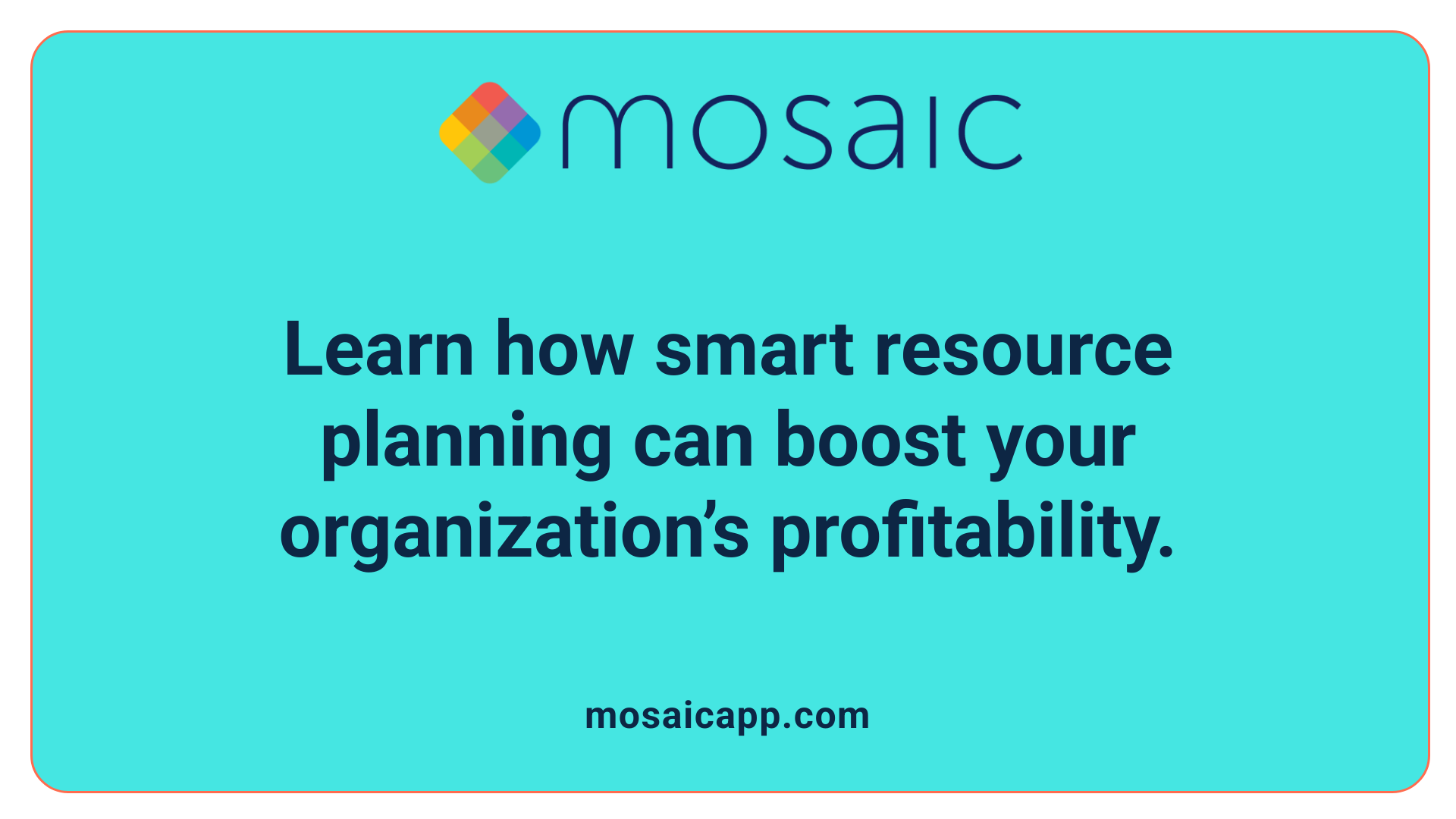
What is the financial impact of effective resource planning?
Implementing efficient resource planning practices has a measurable positive impact on a company's financial health. Firms that adopt advanced resource management solutions can experience profitability improvements of approximately 5%. This boost stems from better utilization of staff and more optimized project workflows.
Profitability gains
Resource management software enables sharper visibility into workloads and project demands, which helps organizations avoid costly bottlenecks and delays. By streamlining resource allocation, firms reduce idle time and task overlaps, contributing directly to profit margin enhancement.
Increased billable hours
Another financial benefit is the observed 7% increase in billable hours. Software platforms accurately match employee skills and availability to project needs, ensuring more work time is charged to clients, maximizing revenue generation.
Reduction in manual data entry
These systems also significantly reduce the hours spent on manual data entry by automating scheduling and time tracking tasks. This efficiency gain allows employees to focus on higher-value activities, reinforcing productivity and financial results.
Through the integration of centralized data and real-time resource tracking, organizations can strategically manage both project execution and associated budgets. The result is a smoother workflow and healthier bottom line, underscoring the value of smart resource planning.
Who Is Responsible for Resource Management?
Roles involved in resource planning
Resource management is a critical function that ensures projects have the right people and resources at the right time to meet objectives. Typically, responsibility for resource planning lies with several key roles depending on organizational setup.
- Resource Managers often oversee allocating personnel, balancing workloads, and responding to project demands.
- Chief Operating Officers (COOs) may manage or supervise resource planning within larger organizations, focusing on overall operational efficiency.
- Project Management Offices (PMOs) play a strategic role by establishing resource management standards and assisting project managers.
- Project Managers generally handle day-to-day resource scheduling and adjustments to keep projects on track.
Variations by company size and structure
In smaller companies, project managers often take on resource management duties directly due to fewer hierarchical layers. Larger and more complex organizations tend to have dedicated resource managers or COOs, supported by PMOs, to coordinate across multiple teams and projects.
Such a layered approach ensures that resource planning integrates with broader operational and financial goals. The responsible roles collaborate closely to monitor resource availability, track utilization, and adjust allocations dynamically, using software tools and processes tailored to their company’s needs.
Answer to "Which roles typically manage resource planning?"
Resource management responsibilities generally involve resource managers, COOs, PMOs, or project managers, depending on the company’s size and organizational structure, each overseeing planning, allocation, and monitoring to meet project goals.
Key Considerations When Choosing a Resource Management Platform
What factors influence the selection of resource management software?
Selecting the ideal resource management platform requires a careful balance of several crucial factors. Ease of use is paramount to ensure widespread adoption and minimize the learning curve for teams. Platforms like monday work management and Atlassian offer intuitive interfaces and customizable workflows to cater to diverse user needs.
Vendor partnerships significantly impact software capability and support. For example, Dayshape's collaborations with Workday, Salesforce, and Oracle enhance its integration depth and functionality, especially for large, complex organizations.
Industry-specific expertise enables platforms to tailor features for unique operational demands. Dayshape’s AI-driven scheduling is designed for professional services firms with over 500 employees, while others like BigTime focus on growing companies requiring combined resource and financial planning.
Integration capabilities remain critical, as seamless connectivity with existing systems such as ERP, CRM, and financial tools ensures centralized data and improved workflow automation. Platforms like Atlassian excel here, integrating with Jira, Confluence, and over 1,000 apps, supporting robust project collaboration.
Evaluating these factors helps select a platform that aligns with organizational complexity, enhances productivity, and supports strategic resource management objectives.
Industry-Specific Solutions and Their Unique Features
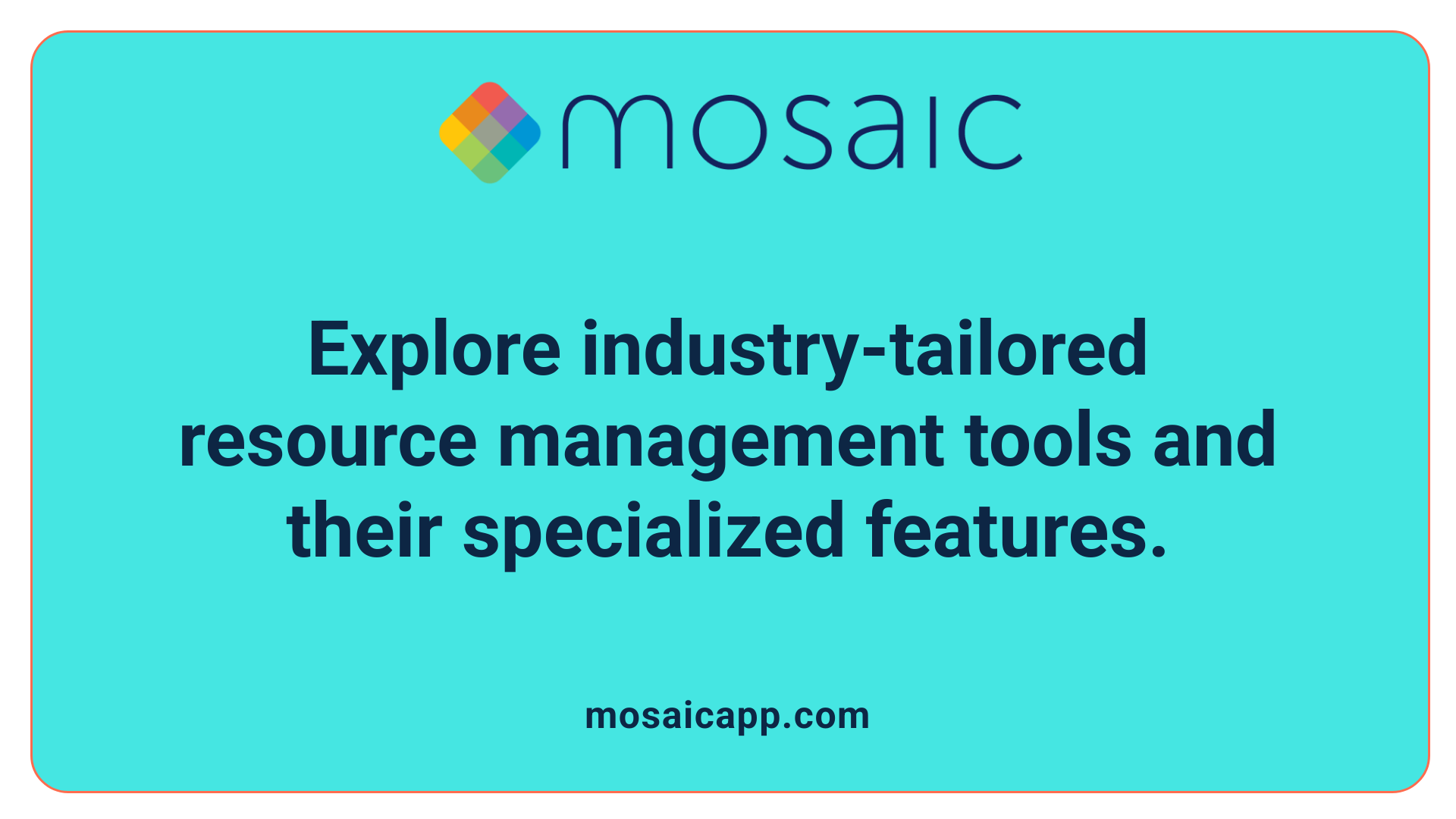
How do resource management platforms address unique industry needs?
Resource management platforms are increasingly designed to meet the distinct requirements of various industries by incorporating specialized features such as skills mapping, tailored automation, and straightforward scheduling functions. These adaptations help organizations allocate resources in a manner that aligns precisely with their industry workflows and workforce demands.
For example, platforms like Beeye, ProFinda, and Eightfold emphasize skills mapping, allowing firms—especially in IT and consultancy sectors—to match employee skills with project needs. This ensures resources are deployed efficiently based on expertise and availability.
Automation tailored for specific sectors enhances workflow efficiency. Tools like Motion use AI-powered task scheduling and project workflow templates to automate task assignments and progress, which benefits fast-paced industries requiring agile project management.
Professional services firms, such as large consultancies, often adopt platforms like Dayshape. This software integrates AI-based resource scheduling with real-time financial insights, providing advanced capabilities especially suited for firms with complex, multi-project environments and large employee bases.
IT teams might select solutions emphasizing collaboration and integration, such as Atlassian’s Jira and Confluence, which support customizable workflows and seamless connections with other software development tools.
By targeting industry-specific challenges—from workforce skills to project complexity and integration needs—these platforms optimize resource allocation, streamline processes, and support project success tailored to their unique environments.
Real-World Success Stories and Industry Adoption
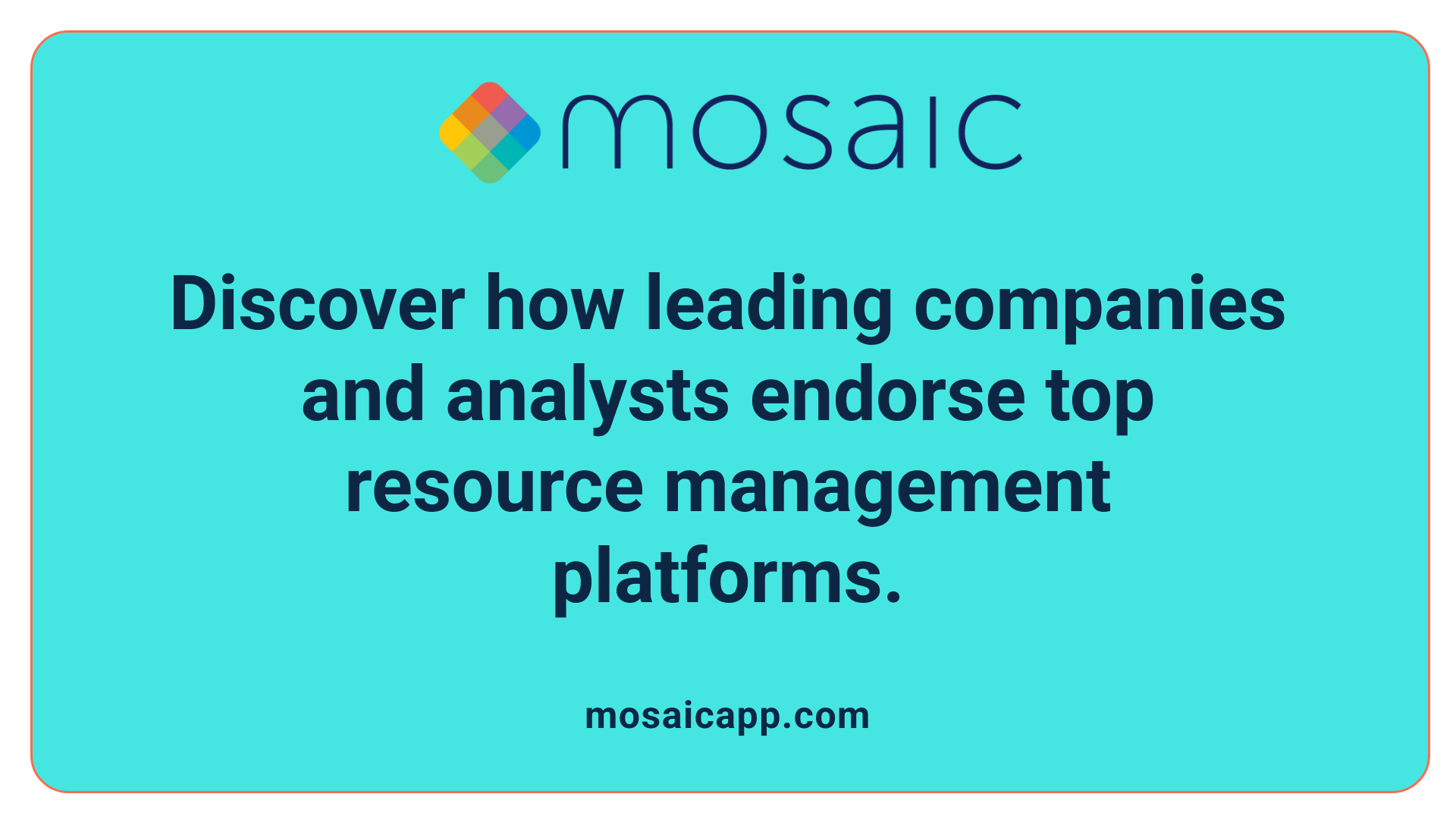
Which major companies and analysts endorse these platforms?
Several well-known corporations rely on leading resource management platforms to streamline project planning and enhance team collaboration. Notably, Amazon, Adobe, Microsoft, and NASA are among the major companies that utilize Atlassian’s resource management tools. Their adoption reflects the robustness and scalability of these platforms to meet the complex demands of large enterprises.
Recognition by industry analysts
Industry analysts have also recognized the value and performance of these tools. Gartner, a highly respected research and advisory firm, has identified Jira as a leader in agile project management software. Similarly, Confluence — Atlassian’s collaboration platform — is lauded as a leader in enterprise content management and collaboration solutions. Such endorsements underline the platforms' industry reliability and innovation.
Case examples highlighting platform strengths
Atlassian’s suite, including Jira and Confluence, supports extensive customizability with over 25 project management templates and seamless integration with hundreds of apps. These features allow large organizations to tailor workflows precisely to their needs, promoting efficiency and visibility across teams. The platforms’ deep integration capabilities and real-time project tracking facilitate proactive resource management, helping companies to prevent delays and optimize task assignments.
Together, endorsements from global tech giants and recognition from top analysts demonstrate how these tools drive successful project outcomes and provide critical support for complex, large-scale operations.
Future Trends in Resource Planning and Project Staffing
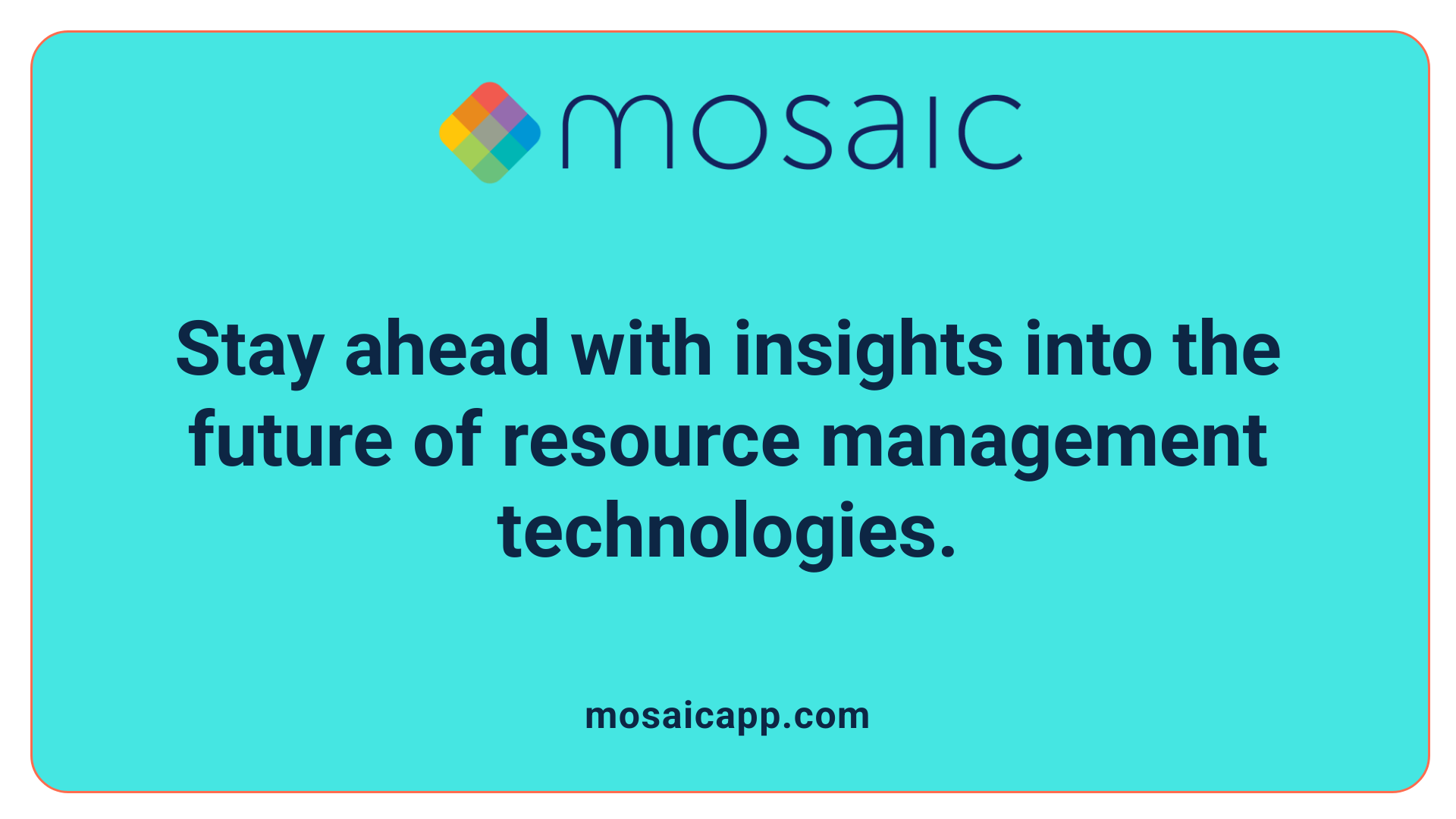
What is the future outlook for resource management platforms?
The future of resource management platforms is set to be shaped by three major trends: increasing AI adoption, deeper automation, and enhanced real-time collaboration.
Increasing AI Adoption
Artificial intelligence is becoming integral to optimizing resource scheduling and utilization. Platforms like Dayshape use AI to analyze multiple projects and improve resource utilization by 3-6%. Similarly, Motion leverages AI to auto-assign tasks, adjust schedules dynamically, and proactively alert teams about potential project delays. These AI capabilities reduce manual workload and improve decision-making accuracy.
Deeper Automation
Automation will move beyond basic scheduling to encompass entire workflows. For example, Motion's Project Workflow Templates automate task assignments and progression, streamlining project staffing with minimal manual input. Automation also extends to financial linkages, as seen in BigTime, which connects resource plans to budget and profitability modeling, allowing proactive financial management.
Enhanced Real-Time Collaboration
Future platforms will offer improved visibility and communication tools to foster collaboration across teams and departments. Atlassian's software ecosystem—including Jira and Confluence—already provides seamless integration and collaborative templates trusted by major organizations. These tools enable real-time workload analysis and resource allocation, making it easier for companies to respond instantly to changing project demands.
Together, these advancements show that future resource management solutions will be smarter, more integrated, and more responsive, enabling organizations to optimize project success in complex environments.
Empowering Project Teams Through Advanced Resource Planning
As project complexity grows, resource planning platforms equipped with AI, automation, and integrated financial management become essential. They simplify staffing challenges by providing real-time visibility, predictive insights, and seamless collaboration. Organizations that adopt these sophisticated tools stand to improve productivity, profitability, and project outcomes, effectively transforming complex staffing into a streamlined and manageable process.

